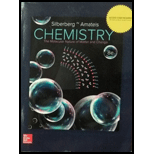
Concept explainers
(a)
Interpretation:
The molecular mass and correct name for the compound is to be determined.
Concept introduction:
Covalent bonds are formed by the sharing of electrons between two or more atoms. In covalent bonding, there is a mutual attraction between two nuclei and the two electrons that reside between them. The elements that engage in covalent bond formation are present at the rightmost corner of the periodic table. These elements are non-metals. The interaction between two non-metal elements leads to the formation of a covalent bond.
The general formula to calculate the molecular mass of a compound is,
(b)
Interpretation:
The molecular mass and correct name for the compound is to be determined.
Concept introduction:
Covalent bonds are formed by the sharing of electrons between two or more atoms. In covalent bonding, there is a mutual attraction between two nuclei and the two electrons that reside between them. The elements that engage in covalent bond formation are present at the rightmost corner of the periodic table. These elements are non-metals. The interaction between two non-metal elements leads to the formation of a covalent bond.
The general formula to calculate the molecular mass of a compound is,
(c)
Interpretation:
The molecular mass and correct name for the compound is to be determined.
Concept introduction:
Covalent bonds are formed by the sharing of electrons between two or more atoms. In covalent bonding, there is a mutual attraction between two nuclei and the two electrons that reside between them. The elements that engage in covalent bond formation are present at the rightmost corner of the periodic table. These elements are non-metals. The interaction between two non-metal elements leads to the formation of a covalent bond.
The general formula to calculate the molecular mass of a compound is,
(d)
Interpretation:
The molecular mass and correct name for the compound is to be determined.
Concept introduction:
Covalent bonds are formed by the sharing of electrons between two or more atoms. In covalent bonding, there is a mutual attraction between two nuclei and the two electrons that reside between them. The elements that engage in covalent bond formation are present at the rightmost corner of the periodic table. These elements are non-metals. The interaction between two non-metal elements leads to the formation of a covalent bond.
The general formula to calculate the molecular mass of a compound is,
Want to see the full answer?
Check out a sample textbook solution
Chapter 2 Solutions
CHEMISTRY >CUSTOM<
- Please predict the products for each of the following reactions: 1.03 2. H₂O NaNH, 1. n-BuLi 2. Mel A H₂ 10 9 0 H2SO4, H₂O HgSO4 Pd or Pt (catalyst) B 9 2 n-BuLi ♡ D2 (deuterium) Lindlar's Catalyst 1. NaNH2 2. EtBr Na, ND3 (deuterium) 2. H₂O2, NaOH 1. (Sia)2BH с Darrow_forwardin the scope of ontario SCH4U grade 12 course, please show ALL workarrow_forwardIs the chemical reaction CuCl42-(green) + 4H2O <==> Cu(H2O)42+(blue) + 4Cl- exothermic or endothermic?arrow_forward
- If we react tetraethoxypropane with hydrazine, what is the product obtained (explain its formula). State the reason why the corresponding dialdehyde is not used.arrow_forwarddrawing, no aiarrow_forwardIf CH3COCH2CH(OCH3)2 (4,4-dimethoxy-2-butanone) and hydrazine react, two isomeric products are formed. State their structure and which will be the majority.arrow_forward
- + Reset Provide the correct IUPAC name for the compound shown here. 4-methylhept-2-ene (Z)- (E)- 1-6-5-2-3-4- cyclo iso tert- sec- di tri hept hex oct meth eth pent ane yne ene ylarrow_forward+ Provide the correct IUPAC name for the compound shown here. Reset H3C H H C CH3 CH-CH3 1-3-methylpent ene trans- cis- 5-6-3-1-2-4- tert- tri sec- di cyclo iso but pent hex meth prop eth yl ane ene yne ☑arrow_forwarddrawing, no aiarrow_forward
 ChemistryChemistryISBN:9781305957404Author:Steven S. Zumdahl, Susan A. Zumdahl, Donald J. DeCostePublisher:Cengage Learning
ChemistryChemistryISBN:9781305957404Author:Steven S. Zumdahl, Susan A. Zumdahl, Donald J. DeCostePublisher:Cengage Learning ChemistryChemistryISBN:9781259911156Author:Raymond Chang Dr., Jason Overby ProfessorPublisher:McGraw-Hill Education
ChemistryChemistryISBN:9781259911156Author:Raymond Chang Dr., Jason Overby ProfessorPublisher:McGraw-Hill Education Principles of Instrumental AnalysisChemistryISBN:9781305577213Author:Douglas A. Skoog, F. James Holler, Stanley R. CrouchPublisher:Cengage Learning
Principles of Instrumental AnalysisChemistryISBN:9781305577213Author:Douglas A. Skoog, F. James Holler, Stanley R. CrouchPublisher:Cengage Learning Organic ChemistryChemistryISBN:9780078021558Author:Janice Gorzynski Smith Dr.Publisher:McGraw-Hill Education
Organic ChemistryChemistryISBN:9780078021558Author:Janice Gorzynski Smith Dr.Publisher:McGraw-Hill Education Chemistry: Principles and ReactionsChemistryISBN:9781305079373Author:William L. Masterton, Cecile N. HurleyPublisher:Cengage Learning
Chemistry: Principles and ReactionsChemistryISBN:9781305079373Author:William L. Masterton, Cecile N. HurleyPublisher:Cengage Learning Elementary Principles of Chemical Processes, Bind...ChemistryISBN:9781118431221Author:Richard M. Felder, Ronald W. Rousseau, Lisa G. BullardPublisher:WILEY
Elementary Principles of Chemical Processes, Bind...ChemistryISBN:9781118431221Author:Richard M. Felder, Ronald W. Rousseau, Lisa G. BullardPublisher:WILEY





